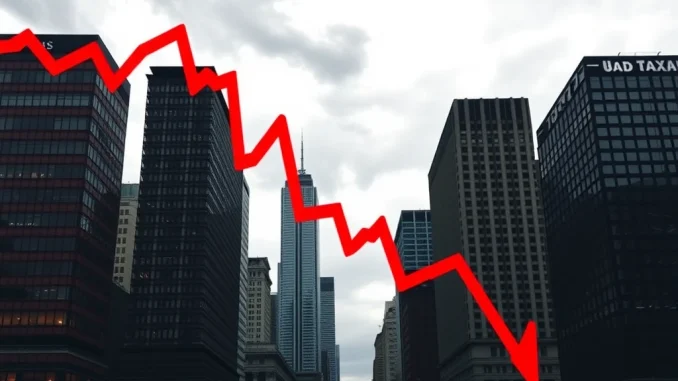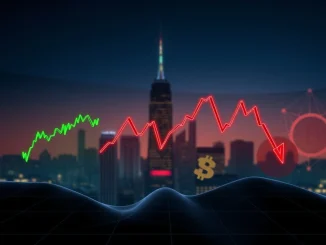
Brace yourselves, investors! The opening bell on Wall Street just rang, and it’s not exactly music to the ears. Major U.S. stock indexes have started the day in the red, painting a somewhat concerning picture for the immediate trading session. For those watching the broader financial landscape, including the crypto markets which often take cues from traditional finance, this stock market dip is definitely worth paying attention to.
Why is the Market Open Lower Today?
Let’s dive into what’s causing this initial downturn. While it’s still early in the trading day, several factors could be contributing to the cautious sentiment as reflected in the market open lower. Here’s a quick snapshot:
- Economic Data Jitters: Recent economic data releases might be creating uncertainty. Investors are constantly analyzing inflation figures, jobs reports, and GDP growth for clues about the economy’s health. Any perceived weakness or unexpected data can trigger a negative reaction.
- Interest Rate Concerns: The specter of further interest rate hikes by the Federal Reserve always looms large. Higher interest rates can make borrowing more expensive for companies and consumers, potentially slowing down economic growth and impacting corporate earnings.
- Geopolitical Uncertainty: Global events always play a role. Rising geopolitical tensions or unexpected international news can inject volatility into the markets as investors become risk-averse.
- Profit Taking: After periods of gains, some investors might be engaging in profit-taking, selling off some of their holdings to secure returns. This can naturally lead to downward pressure on stock prices.
Breaking Down the Key Indexes: S&P 500, NASDAQ, and Dow Jones
Let’s look at the numbers to understand the breadth of this initial market reaction. The three major indexes are all showing declines, indicating a widespread cautious mood.
S&P 500: Broad Market Indicator in the Red
The S&P 500, often seen as the most representative index of the overall U.S. stock market, is currently showing a decrease of 0.21%. While not a dramatic plunge, it signals a negative start across a wide range of large-cap companies. Investors are using the S&P 500 to gauge the general sentiment and direction of the market. A dip here can be interpreted as a broad-based concern.
NASDAQ: Tech Sector Under Pressure
The NASDAQ Composite, heavily weighted towards technology stocks, is down by 0.18%. The tech sector is often seen as more sensitive to interest rate changes and economic growth prospects. A slight dip in the NASDAQ could suggest some pressure on growth stocks, potentially reflecting concerns about future earnings in a potentially slowing economy.
Dow Jones: Blue-Chip Stocks Also Affected
The Dow Jones Industrial Average, composed of 30 large, well-established blue-chip companies, is showing the largest decline among the three, down by 0.26%. This suggests that even established, traditionally稳健 (wěn jiàn – stable/steady) companies are feeling the initial market unease. The Dow’s performance reflects the sentiment around mature, industrial sectors of the economy.
| Index | Change |
|---|---|
| S&P 500 | -0.21% |
| NASDAQ | -0.18% |
| Dow Jones | -0.26% |
What Does This Mean for Crypto?
You might be wondering, what does a stock market dip have to do with cryptocurrency? While the crypto market operates 24/7 and has its own unique drivers, it’s not entirely insulated from traditional financial markets. Here’s how events in the stock market can ripple into the crypto sphere:
- Risk Sentiment: Both stock and crypto markets are influenced by overall risk sentiment. When investors become risk-averse, they tend to pull back from riskier assets, which can include both stocks and cryptocurrencies. A downturn in the stock market can sometimes trigger a similar reaction in crypto.
- Investor Behavior: Many investors hold both traditional and crypto assets. Margin calls or a general desire to reduce portfolio risk in a declining stock market could lead to selling pressure in crypto as well.
- Macroeconomic Outlook: The same macroeconomic factors that influence the stock market (inflation, interest rates, economic growth) also impact the broader investment environment, which includes crypto.
- Correlation (Sometimes): While not always perfectly correlated, there can be periods where stock and crypto markets show increased correlation, especially during times of economic uncertainty or market volatility.
Actionable Insights: Staying Informed and Prepared
While a single day’s market opening is just one data point, it’s crucial to stay informed and understand potential market dynamics. Here are a few actionable insights:
- Monitor Market News: Keep an eye on financial news throughout the day to understand if the initial market open lower trend continues or if the market recovers. Pay attention to any news releases or events that might be influencing market sentiment.
- Review Your Portfolio: Assess your investment portfolio in both traditional and crypto assets. Understand your risk tolerance and ensure your portfolio aligns with your financial goals.
- Stay Calm and Avoid Panic Selling: Market fluctuations are normal. Avoid making impulsive decisions based on short-term market movements. Long-term investment strategies often weather short-term volatility.
- Do Your Research: Continue to research the factors impacting both stock and crypto markets. Understanding the underlying dynamics will help you make more informed investment decisions.
Conclusion: Navigating Market Volatility
The U.S. stock markets have opened lower today, reflecting a cautious start to the trading day. While the initial declines in the S&P 500, NASDAQ, and Dow Jones are modest, they serve as a reminder of the inherent volatility in financial markets. For crypto investors, understanding the dynamics of traditional markets and their potential, albeit sometimes indirect, influence on the crypto space is essential. Staying informed, maintaining a long-term perspective, and avoiding emotional reactions are key to navigating market fluctuations and achieving your investment objectives. Keep watching the markets closely – the day is still young, and market sentiment can shift quickly.



